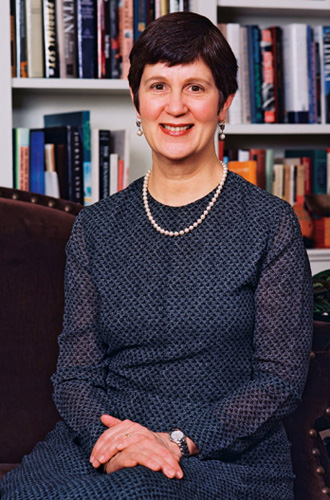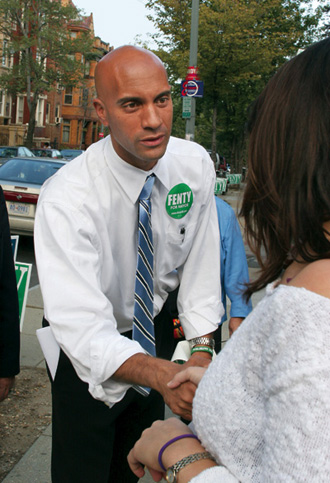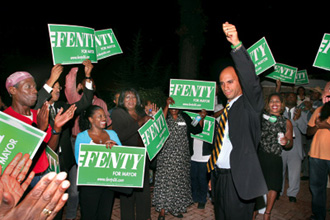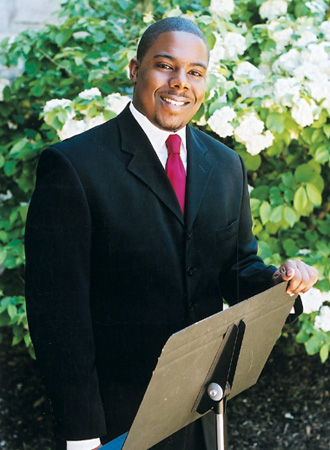Oberlin Alumni Magazine
Fall 2006 Vol. 102 No. 2
Around Tappan Square

President Dye to Retire in June
As this issue of OAM was in production, Oberlin President Nancy S. Dye announced that she will retire at the end of this academic year: June 30, 2007. Dye’s presidency, as well as updates on the search process, will be fully explored in upcoming issues of this magazine.
“I cannot imagine any job in the world as fascinating, exhilarating, or personally and professionally challenging as mine,” Dye told members of the Oberlin Alumni Council, which met for its annual meeting September 15-17. “One of the great pleasures of my life over the past 12 years has been meeting so many unbelievably interesting and accomplished people who are Oberlin alumni. It is a particular pleasure to hear from and keep in touch with alumni who graduated during my presidency, and to learn about their ever-remarkable accomplishments and achievements. I look forward to keeping up my relationships with you.”
Board of Trustees Chair Robert Lemle ’75, who will help lead the search for Dye’s replacement this year, says the Board accepted her decision with regret, yet also with admiration for her hard work and achievement. “Nancy leaves an Oberlin College that is poised for continued success, with a clear mission and strategic and financial goals and direction,” he says.
Among Dye’s more notable achievements during the past 12 years was building Oberlin’s endowment, which grew from about $260 million in 1994 to its current level of about $700 million. Other highlights of her tenure include the Science Center, which opened in 2002; record numbers in admissions; changes in the Dean of Studies office, which have led to a more student-centered campus; and a successful town-gown partnership focusing particularly on the Oberlin public schools.
Dye says that other key projects—such as implementing certain elements of the new Strategic Plan—will remain her top priority this year. “We want to turn the main floor of Mudd library into an academic commons that would reestablish the centrality of the library as the center of the campus,” she told alumni. “This commons will pull together many central library and student academic services, host musical programs and academic lectures, and feature a café.”
With a specific interest in reestablishing relationships with colleges and universities in the Middle East, Dye says she will work personally on recruiting more students from that region and pushing for exchange programs between Oberlin and Iranian colleges. “Oberlin has made me a confirmed and ardent internationalist,” she says.
The search for a new president was to begin officially at the October meeting of the Board of Trustees. Lemle expects that faculty, alumni, and students will be represented on the search committee.


Adrian Fenty ’92 Prepares to Lead Washington, D.C.
Adrian Fenty’s first taste of politics came as an Oberlin College sophomore. Now, he’s about to join a banquet.
An English and economics major in college, Fenty ’92 is poised to become mayor of the District of Columbia. He enjoyed a sweeping victory in the Democratic primary in September, which, for the majority-Democratic city, all but guarantees a win in the November election.
This will make the 35-year-old, two-term city councilman the youngest elected mayor in D.C. history. But more striking, say pundits, is his ability to unite voters who are traditionally divided by race.
“It was a historic performance,” wrote the Washington Post following Fenty’s September 12 win. “Fenty is the first mayoral candidate to win every precinct in the historically decisive Democratic primary since the advent of home rule in 1974.”
Most striking, say political veterans, was Fenty’s ability to carry the city’s largely white wards in northwest Washington and its predominantly African American wards. He waged a relentless 15-month, door-to-door campaign, gaining at least 52 percent of the vote in every ward and leading rival Linda W. Cropp by 26,000 votes.
Fenty’s feat is no great surprise to Oberlin Professor of Politics Paul Dawson, whom Fenty called “the most influential person” he encountered at Oberlin.
“I always thought Adrian had what it took to be a successful and inspiring political leader,” Dawson says. “He had a compelling vision of what government could do and a relentless, inquiring mind that actively searched for a better way of doing the people’s business. What impressed people most was his determination to find ways to link the diverse interests of different groups in a common endeavor, one that advanced the well-being of all.”
As an aspiring lawyer while at Oberlin (he went on to graduate from Howard University Law School), Fenty took an internship with then-Senator Howard Metzenbaum (D-OH). He says it helped prove his belief that the needs of people are basically the same all over.
His mayoral platform is based largely on D.C.’s “lingering problems”—troubled schools, an unresponsive police department, and “dysfunctional” agencies. Seventeen percent of the city’s families live below the poverty line, compared to 10 percent of families nationwide.
One of his toughest decisions will be whether to try taking control of the public schools, which are overseen by an independent board of elected and mayor-appointed members. Fenty has also pledged to spend $1 billion on affordable housing and neighborhood redevelopment programs, and to spend more on public safety.
While Fenty’s critics say he lacks the experience to manage a $7 billion budget, others believe he has the smarts, energy, and vision to make needed change. His entry into D.C. politics occurred in 2000, when he captured a city council seat that had long belonged to another Oberlin graduate: Charlene Drew Jarvis ’62. Fenty had little political experience at the time, but he had worked in law and in business.
Fenty hopes to visit Oberlin on November 10 for a post-election conference sponsored by the Oberlin Initiative in Electoral Politics. Look for conference coverage, plus more about Fenty and other candidates, in the winter issue of OAM.
Students Learn to “Stay Sane in a Crazy World”
“I’m concerned,” says freshman Joey De Jesus. “You hear about mosques being burned, nuns being shot out of hatred, people in our own country suffering for various reasons, cities being leveled, hurricanes. This class, I hope, will help me understand the human psychological toll that is most important in today’s world.”
That’s the idea, says Associate Profes-sor of Psychology Karen Sutton. Her first-year seminar, Staying Sane in a Crazy World: The Human Impact of War, Terrorism, and Natural Disasters, examines new aspects of psychology—events that don’t just affect an individual, but everyone around them. “So far we’ve been trying to define what healthy behavior in such cases is”—a line of reasoning just beginning to be studied in psychology, she says.
It’s a tough subject, but one that fits well into the scope of Oberlin’s first-year seminar program, designed four years ago to develop critical thinking and writing skills while also grooming new students for Oberlin’s intellectually charged environment.
Topics such as the war in Iraq, women in Iran, the Japanese-American internment during World War II, and Hurricane Katrina are helping Sutton’s students examine an emerging theory that some people are hard-wired from birth to flourish in the face of everyday trauma; students are also looking at what types of life experiences contribute to a person’s ability to bounce back after tragedy. Memoirs, news articles, and psychological journals act as study guides.
“People who encounter disasters can still flourish,” Sutton says. It’s a reassuring statement for students like freshman Allison Mayer. A New Orleans native, she is especially interested in the part of the class that will cover Hurricane Katrina. “I hope to learn about the different ways that people have coped with traumatic experiences over time,” she says. “I definitely think it ties into real life, especially those of mine and other people who have gone through similar experiences with other disasters.”
News and Notes
College Gains Acting Dean
Jeff Witmer, professor of mathematics, was made acting dean of the College of Arts and Sciences in September following the resignation of Dean Harry Hirsch. Witmer joined Oberlin in 1986 and was appointed acting dean during the 2004-05 school year. He’s held past positions as associate dean of Arts and Sciences, associate provost, and chair of the mathematics department. A permanent dean is expected to be installed during the 2007-08 academic year.
Bad Address? Let Us Know!
The Division of Development and Alumni Affairs began implementing new data systems recently, which affects the storage of alumni contact information. If your name or address appears incorrectly on the mailing label of this magazine, please let us know, either through ObieWeb (www.oberlin.edu/alumni), by e-mail to alumni@ oberlin.edu, or by phone at (440) 775-8692. Thank you for your patience as we update our records.
Attention Basketball Alumnae!
It’s the 30th Anniversary of Varsity Intercollegiate Women’s Basketball at Oberlin! We traditionally have held our annual alumnae basketball game in January; our 2007 game was scheduled for Saturday, January 13. However, we now are considering combining our event with the men’s alumni game, scheduled for the weekend of February 16-17. The proposed schedule would include the women’s alumnae game on Friday at 7 p.m., the men’s alumni game on Saturday morning, and the usual varsity doubleheader on Saturday afternoon. Of course, there would be much food and socializing built in to the weekend as well! Please offer us your feedback on whether you would prefer a combined event in February, or our planned separate event on January 13. E-mail a note to Coach Christa Champion at christa.champion@ oberlin.edu or call (440) 775-8546.
Oberlin Roots Inspire South African Educator
Nearly 100 years have passed since a 16 year-old South African boy named John Dube arrived in Oberlin with “only his clothing and two shillings,” accompanying his missionary mentor, Rev. William Wilcox, an 1878 Oberlin graduate. Dube would go on to embrace the values of educational freedom and become a key figure in influencing South Africa’s development of democracy.
His legacy—and the Oberlin roots that inspired his work in politics, education, religion, and journalism—are featured in a new documentary film produced by Cherif Keita, professor of French and Francophone literature at Carleton College.
Oberlin-Inanda: The Life and Times of John L. Dube, a 55-minute documentary filmed in Oberlin and South Africa, traces Dube’s journey from South Africa to Oberlin in 1887. For two years he attended the Oberlin Preparatory Academy, taking courses in science, math, and classical Greek works. He worked at the College and at a local printing firm and attended the Second Congregational Church; all were experiences that would greatly influence his world outlook.
Dube went on to establish the first African-controlled school in South Africa, promoting his belief in education, independence, and self-reliance for all Africans. He would also become a noted public speaker, editor and founder of a newspaper, author, international civil rights leader, and founding president of the African National Congress, the political organization primarily responsible for overthrowing apartheid and which is at the pinnacle of power in South Africa today.
Screened twice at Oberlin, the film offers commentaries from Professors of African American Studies Yakubu Saaka and James Millette, Professor of History Carol Lasser, Associate Professor of Religion A.G. Miller, and Affiliate Scholar Marlene Merrill. The Oberlin College Archives provided documents and photos for the film, two DVDs of which are available in Mudd library. Emeritus Professor of Sociology Albert J. McQueen, acting on behalf of the Alumni Association’s Executive Board, was instrumental in bringing Keita and his film to campus.
Dube was a builder of bridges between nations, says Keita, a native of Mali, West Africa. “Throughout his life Dube remained loyal to the Oberlin spirit. He approached the College on behalf of many young South Africans, for whom he saw the Oberlin spirit as an important viaticum for their life journey.”
In South Africa in 1900, with a small band of supporters, Dube built the Ohlange Institute, which was based on his Oberlin experiences and the influence of another mentor and educator, Booker T. Washington. Over time the school was called a “citadel of light,” whose graduates now include many prominent Africans and many of the women in the South African Parliament. The school is so symbolically important that former South African Presi-dent Nelson Mandela strongly praised Dube’s pioneering work and chose it as the place to cast the first vote in the nation’s first free election in 1994.
“When I think of where he started and what he accomplished, it boggles my mind,” Keita says. Dube saw education as the only protection against colonial tyranny and held firm to his beliefs that blacks should have economic and political independence.
“John Dube’s example proves that an investment in education is the best weapon against fanaticism and sectarianism,” says Keita.
The film won honors in the Pan-African film festival last year and was selected for screening at the Durban (South African) International Film Festival and the New York Diaspora Film Festival. It was scheduled to be shown this fall in the Brazilian capital city in conjunction with the Tripar-tite Political Summit of leaders of Brazil, India, and South Africa.
As the film spreads the word about John Dube, another very valuable thing is happening: “It is also spreading the word about Oberlin College,” McQueen says.
 John Harper ’08
John Harper ’08
Project Leadership
Shortly after leaving his Georgetown University dorm room each morning, Oberlin vocal performance and African American studies major John Harper ’08 would join his fellow scholars for an hour-long course in economics, or perhaps political science. Afterward, it was off to his summer internship with the National Endowment for the Arts, followed later by a private tour of the West Wing, or a Con-gressional briefing at the Capitol, or a hobnobbing session with Civil Rights activist Vernon Johnson or General Colin Powell.
Harper was one of a handful of students accepted into the Washington, D.C.-based Institute for Responsible Citizens, a highly selective summer leadership program meant to inspire minority male college students “to become exemplary citizens for life.” Each year, the institute accepts 12 students for two summers of academic work, career preparation, and mentoring and social opportunities.
“I had the chance to get to know public officials and understand their points of view,” Harper says. “I learned that people with different political allegiances want the same things, especially when it comes to the community.” That’s exactly what program founder William Keyes was counting on when he tapped government officials to take part in the institute four years ago.
Harper, who has been singing and dancing since childhood, is involved with the Black Student Union at Oberlin and the Admissions Student Advisory Council; he’s also an RA. “When I graduate, I know that I want to sing, but I also want to open a community center for the performing arts,” he says.
“If kids are shown options—that blacks dance in ballets, sing in operas, etc.—they will see that they can do it too. With all the encouragement and mentoring offered by the institute, if one of us doesn’t succeed in making an impact in the community, it won’t happen.”
Learning Through Labor: Oberlin’s 10th annual Day of Service, now an Orientation Week tradition, placed 300 new freshmen in 16 volunteer sites throughout Lorain County on September 2, including Oberlin’s Murray Ridge Group Home. “It’s rare to find a place where so many students so readily volunteer their time to serve the community,” says Avery Brook ’04, community service coordinator at the Center for Service and Learning. “This is such a unique and inspiring tradition, so much so that other schools have begun calling to ask how to organize one of their own.” Web Extra: To view a Day of Service slide show, visit: www.oberlin.edu/oam.
Hurry Up, Make a Decision!
As a college student 20 years ago, Michael Loose told his advisor that he was interested in “how people think.” The field was too elusive, his advisor warned, so Loose instead turned to neuroendocrinology, focusing specifically on a group of puberty-dictating neurons at the base of the brain. But with a recent coming-of-age in the field of cognitive neuroscience, Loose says he’s taken the plunge into studying the decision-making behavior of “whole” people by the use of electroencephalography, or EEG.
“My summer research student, Natanya Schessel ’08, and I wanted to know if the neural circuits involved in ‘wanting’ something to happen interacted with a particular brain system that is affected by knowing the probability that something will happen,” says Loose, an associate professor of neuroscience. “Our results suggest there is an interaction in the particular neural circuits we are studying.”
To get this result, Loose and Schessel tested 12 college-age participants. Subjects were fitted with a 32-electrode malleable head net and placed in a room with a computer and a button. For an hour, they were instructed to push the button when the letter “a” popped up on the screen, but not when a “q” was shown. This simulated what Loose describes as a “go, no-go” situation, when subjects could be thinking, “Should I push? Shouldn’t I? Why?” Volunteers had 425 milliseconds to make their decisions, while the EEG displayed records of their brain activity on a computer in the next room.
During the trials, the element of reward for a “timely and correct button push” was factored in, as were factors of personality, which were determined by a pre-test questionnaire given to volunteers. Statements such as “I often act on the spur of the moment” or “I worry about making mistakes” were rated to help the researchers correlate measures of impulsivity, hesitancy, and expectation.
“People make decisions in part based on how likely an outcome is thought to be and in part on the level of reward they can expect,” says Loose. “However, it is unknown when and where these two factors are integrated by the brain. The neural circuits that produce the particular brain activity we are measuring may be one site where one’s ‘wants’ and ‘expectations’ are integrated. The experiments this summer and those we are continuing this fall are designed to test this hypothesis. I’m excited.”
A collaboration with Oberlin’s psychology department—particularly with Associate Professor of Psychology Al Porterfield—has been critical to Loose’s work, he says. The pair first used EEG experiments in 2004 to examine how rapidly people responded to new information. This newest data on decision-making and reward will be used in congruence with further collaborative studies on probability.
“It’s great that our departments were able to work together and purchase the needed equipment,” says Porterfield. “It was also great fun collaborating with Mike on the ground floor of what may well turn into a very important program of research.”
Republicans’ Lecture Series Brings Divergent Opinions to Oberlin
Syndicated columnist, blogger, and Fox News contributor Michelle Malkin ’92 was met with an overflow audience last spring upon delivering a campus lecture titled “Unhinged: Exposing Liberals Gone Wild,” based on her new book by the same name. Broadcast on C-SPAN2’s BookTV, her comments sparked a flurry of raised hands and lasting debate among students.
Malkin was the first speaker in the newly created Ronald Reagan Political Lecture-ship Series, an effort initiated last year by Oberlin College Republicans President Barry Garrett ’06 and funded by alumnus Steven Shapiro ’83.
“OC Republicans agreed that most of our energies should be spent attracting conservative speakers to campus; most of us felt that the liberal bias of many College-sponsored speakers needed to be addressed,” says Garrett.
Shapiro, president of Intrepid Capital Management in New York, had previously helped fund campus visits by New York Times columnist David Brooks and former Reagan economics advisor Art Laffer. His hope is that the new series and other efforts by OC Republicans will help broaden the political viewpoints heard on campus. “It’s important to have assumptions challenged,” he says. “It creates a more dynamic environment.”
Current OC Republicans President Jonathan Bruno ’07 says there is certainly a receptive audience at Oberlin for conservative speakers. “There are a startling number of conservative students on campus,” he says. “Some choose to be less vocal about their ideas. I also think there’s a very large group of students who are moderates, people who don’t subscribe to any one set of political ideas—liberal or conservative.”
Malkin’s visit was followed by a lecture in May by Wall Street Journal editorialist John Fund. Among the speakers this semester are Kate Obenshain Griffin, chair of the Republican Party of Virginia; William Kristol, editor of the Weekly Standard and a Fox News commentator; and Patrick Michaels, a senior fellow at the Cato Institute and a research professor of environmental sciences.
The OC Republicans was reestablished in April 2005 after a decade of inactivity. Today, says Bruno, the organization has a core group of active members with a great deal of ideological diversity. “Some members would call themselves libertarians; others, fiscal conservatives; and others, social conservatives,” he says. “These students have come together to make the OC Republi-cans one of the most active student organizations on campus.”
For the latest news on the OC Republicans, visit www.oberlin.edu/stuorg/ocr/.
Last spring, in addition to the lecture series, the group sponsored a two-week drive with the USO to collect care package donations for American soldiers in Iraq and Afghanistan; a lecture on the history of the Republican party; and a debate on capital punishment between California public defender Robin Kallman ’80 and Ohio Deputy Attorney General Matt Hellman, co-sponsored by the Oberlin College ACLU.
“In my mind, no matter how good a college is, it can only be bettered by having a healthy mix of political ideas,” Garrett says. “Ideas need to be examined and rigorously challenged, and academia is one of the few precious places left where, with a little effort, this can be achieved.”
 Common Ground’s distribution tents and office (located in a gutted house) are considered an oasis among the rubble.
Common Ground’s distribution tents and office (located in a gutted house) are considered an oasis among the rubble.
Aid for New Orleans Still Strong, One Year Later
Claire Miller ’07 and dozens of other students made a lengthy commitment to New Orleans during the spring and summer as the city’s problems grew more challenging at the approach of Katrina’s one-year anniversary. Miller landed in the city’s hard-hit Ninth Ward on the night before Mardi Gras, moving her belongings into the rafters of a gutted house that served as Common Ground’s office. She’d joined the organization to offer house-gutting assistance.
Weeks after Miller’s arrival, the New Orleans City Council issued an ordinance requiring that residents gut, mold-remediate, and board up their homes by August 29 or risk having their property seized and bulldozed as a public nuisance. (Certain groups were given exceptions, such as elderly home-owners and some properties in the Ninth Ward.) The mandate was a tall order for the Ninth Ward, which had no electricity or potable water, and thus nowhere for residents to stay while working on their homes. Miller and other volunteers, working to bridge an information gap between the city and residents, compiled a database of all addresses slated for demolition.
“I’m not really sure how I coped,” says Miller, weeks after returning to Oberlin. “We met with residents every night, by gas-light, for as long as it took. It was kind of surreal. … For folks who were able-bodied, we tried to provide ways they could do [the work] themselves.”
“It was about the long-term effects,” adds Lydia Pelot-Hobbs ’07, who worked just yards away from Miller for Critical Resis-tance—a national prison abolitionist organization—on a campaign for amnesty for the nearly 230 people incarcerated for charges related to Hurricane Katrina, such as looting and trespassing.
In addition, Pelot-Hobbs worked with Rachel Luft ’90, a professor of sociology at the University of New Orleans, on an Anti-Racism Working Group, which ran political education workshops with Common Ground’s volunteer base.
“Every day, I want to go back,” says Pelot-Hobbs. “I want to come at it from the standpoint of reconciliation and helping New Orleans to heal.”
If she does go back, some students, like Kwame Webster ’10, will no doubt join in. He grew up in New Orleans East, an area that experienced devastating flooding. A week after he’d started his senior year in high school, his family evacuated to Berkeley, California, where he finished the school year.
But before starting Oberlin this fall, Webster traveled back and forth between his summer job in Berkeley and his neighborhood in New Orleans, where his dad is a pastor. “The weirdest feeling for me was knowing that my whole neighborhood was destroyed,” he says. “Then I would go into other parts of the city and see that nothing had happened.”
